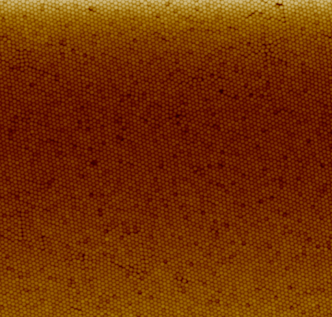Nanosphere lithography
Nanosphere lithography (NSL) is an economical technique for generating single-layer hexagonally close packed or similar patterns of nanoscale features. Generally, NSL applies planar ordered arrays of nanometer-sized latex or silica spheres as lithography masks to fabricate nanoparticle arrays.[1] NSL uses self-assembled monolayers of spheres (typically made of polystyrene, often available commercially as an aqueous suspension) as evaporation masks. These spheres can be deposited using multiple methods including Langmuir-Blodgett, Dip Coating, Spin Coating, solvent evaporation, force-assembly, and air-water interface.[2][3][4][5] This method has been used to fabricate arrays of various nanopatterns, including gold nanodots with precisely controlled spacings.[6]
Nanosphere Monolayer Preparation
Monolayers of nanospheres, to be used as lithography masks can be created using multiple methods:

Langmuir-Blodgett is a deposition method in which the nanoparticles are placed in a Langmuir-Blodgett Trough floating on an aqueous solution, forming a monolayer. With the help of barriers and surface pressure sensor, the particles are compressed into the desired packing density automatically. The coating is done in this packing density with the help of a motorized dipper while the barriers maintain the desired particle packing density. The benefits of the Langmuir-Blodgett method include a strict control over the particle packing density and coating thickness (mono or multilayers can be created) as well as the ability to coat large homogeneous areas.[3] Mask preparation with the Langmuir-Blodgett method has been demonstrated for example using SiO2 particles [7] and polystyrene particles.[8]
Dip Coating is a simplified version of the Langmuir-Blodgett. In dip coating, the nanosphere packing density isn't controlled but the dipping is performed directly on a colloidal particle solution. Dip coating is an effective method for applications where a precise control over the particle distribution isn't required.[3]
Spin Coating and solvent evaporation methods are capable of producing large areas of particles, but with limited control over the layer homogeneity or thickness.[3]
Solvent evaporation is accomplished via drop coating, and is arguably the simplest method to produce a monolayer of nanospheres, as the spheres are simply dropped onto the substrate and allowed to dry, self-assembling into a monolayer. Sometimes the substrate is placed at an angle[9] or moved in circular motions[10] to help the suspension of spheres spread and wet the entire surface.
Force-assembled monolayers are formed from a dry nanosphere powder, which can typically be obtained by centrifugation of a nanosphere suspension. The powder is then rubbed between two substrates to force them into a monolayer.[2] The substrates are typically coated in a polymer such as polydimethylsiloxane (PDMS) to promote adhesion and spreading of the nanospheres.
The air-water interface method relies on the formation of a monolayer of nanospheres on the surface of a water bath, at the air-water interface. In this method, the substrate is held below the surface of the water, and water is then pumped out to gradually lower the surface. Eventually, the water surface is lowered below the level of the substrates, and the monolayer at the air-water interface is deposited onto the substrate surface.[5]
See also
External links
References
- Cheung, C. L.; Nikolic, R. J.; Reinhardt, C. E.; Wang, T. F. (2006). "Fabrication of nanopillars by nanosphere lithography". Nanotechnology. 17 (5): 1339–1343. Bibcode:2006Nanot..17.1339C. doi:10.1088/0957-4484/17/5/028.
- Jang, Dongjin; Kim, Younghoon; Kim, Tae Yun; Koh, Kunsuk; Jeong, Unyong; Cho, Jinhan (2016). "Force-assembled triboelectric nanogenerator with high-humidity-resistant electricity generation using hierarchical surface morphology". Nano Energy. 20: 283–293. doi:10.1016/j.nanoen.2015.12.021.
- Colson, Pierre; Henrist, Catherine; Cloots, Rudi (2013). "Nanosphere Lithography: A Powerful Method for the Controlled Manufacturing of Nanomaterials". Journal of Nanomaterials. 2013: 1–19. doi:10.1155/2013/948510. ISSN 1687-4110.
- C. Zhang, et al. Fabricating Ordered 2-D Nano-Structured Arrays Using Nanosphere Lithography. MethodsX 4, 2017, pp. 229-242. DOI:10.1016/j.mex. open access
- Sirotkin, Evgeny; Apweiler, Julius D.; Ogrin, Feodor Y. (2010-07-06). "Macroscopic Ordering of Polystyrene Carboxylate-Modified Nanospheres Self-Assembled at the Water−Air Interface". Langmuir. 26 (13): 10677–10683. doi:10.1021/la1009658. hdl:10871/12027. ISSN 0743-7463. PMID 20423068.
- Hatzor-de Picciotto, A.; Wissner-Gross, A. D.; Lavallee, G.; Weiss, P. S. (2007). "Arrays of Cu(2+)-complexed organic clusters grown on gold nano dots" (PDF). Journal of Experimental Nanoscience. 2 (1–2): 3–11. Bibcode:2007JENan...2....3P. doi:10.1080/17458080600925807.
- Ching-Mei Hsu, Stephen T. Connor, Mary X. Tang, and Yi Cui (2008). "Wafer-scale silicon nanopillars and nanocones by Langmuir–Blodgett assembly and etching". Applied Physics Letters. 93 (13): 133109. Bibcode:2008ApPhL..93m3109H. doi:10.1063/1.2988893.CS1 maint: multiple names: authors list (link)
- Arno Knapitsch, Etiennette Auffray, George Barbastathis, Celine Chevalier, Chih-Hung Hsieh, Jeong-Gil Kim, Shuai Li, Matthew S. J. Marshall, Radoslaw Mazurczyk, Pawel Modrzynski, Vivek Nagarkar, Ioannis Papakonstantinou, Bipin Singh, Alaric Taylor, Paul Lecoq. "Large scale production of photonic crystals on scintillators". IEEE Transactions on Nuclear Science. 63.CS1 maint: multiple names: authors list (link)
- Liu, Jing; Chen, Chaoyang; Yang, Guangsong; Chen, Yushan; Yang, Cheng-Fu (2017-04-03). "Effect of the Fabrication Parameters of the Nanosphere Lithography Method on the Properties of the Deposited Au-Ag Nanoparticle Arrays". Materials. 10 (4): 381. Bibcode:2017Mate...10..381L. doi:10.3390/ma10040381. PMC 5506964. PMID 28772741.
- Mikac, Lara; Ivanda, Mile; Gotić, Marijan; Janicki, Vesna; Zorc, Hrvoje; Janči, Tibor; Vidaček, Sanja (2017-10-15). "Surface-enhanced Raman spectroscopy substrate based on Ag-coated self-assembled polystyrene spheres". Journal of Molecular Structure. 1146: 530–535. Bibcode:2017JMoSt1146..530M. doi:10.1016/j.molstruc.2017.06.016. ISSN 0022-2860.